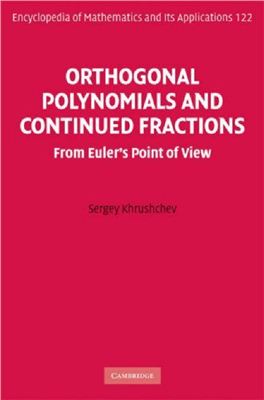Cаmbridge Univеrsity Prеss, 2008. - 496 pages.
This new and exciting historical book tells how Euler introduced the idea of orthogonal polynomials and how he combined them with continued fractions, as well as how Brouncker's formula of 1655 can be derived from Euler's efforts in Special Functions and Orthogonal Polynomials. The most interesting applications of this work are discussed, including the great Markoff's Theorem on the Lagrange spectrum, Abel's Theorem on integration in finite terms, Chebyshev's Theory of Orthogonal Polynomials, and very recent advances in Orthogonal Polynomials on the unit circle. As continued fractions become more important again, in part due to their use in finding algorithms in approximation theory, this timely book revives the approach of Wallis, Brouncker and Euler and illustrates the continuing significance of their influence. A translation of Euler's famous paper 'Continued Fractions, Observation' is included as an Addendum.
This new and exciting historical book tells how Euler introduced the idea of orthogonal polynomials and how he combined them with continued fractions, as well as how Brouncker's formula of 1655 can be derived from Euler's efforts in Special Functions and Orthogonal Polynomials. The most interesting applications of this work are discussed, including the great Markoff's Theorem on the Lagrange spectrum, Abel's Theorem on integration in finite terms, Chebyshev's Theory of Orthogonal Polynomials, and very recent advances in Orthogonal Polynomials on the unit circle. As continued fractions become more important again, in part due to their use in finding algorithms in approximation theory, this timely book revives the approach of Wallis, Brouncker and Euler and illustrates the continuing significance of their influence. A translation of Euler's famous paper 'Continued Fractions, Observation' is included as an Addendum.

